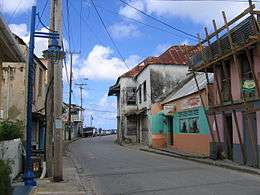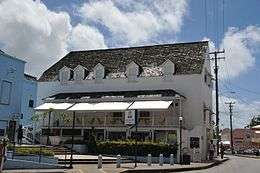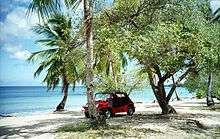Speightstown
Speightstown (/ˈspaɪtstaʊn/), also known as Little Bristol, is the second largest town centre of Barbados. It is situated 12 miles (19 km) north of the capital city of Bridgetown, in the northern parish of Saint Peter.
Speightstown | |
|---|---|
Town | |
Causal view of Queen's Street, Speightstown | |
 Speightstown | |
| Coordinates: 13°15′16″N 59°38′27″W[1] | |
| Country | Barbados |
| Parish | Saint Peter |
| Elevation | 11 m (36 ft) |
| Population (2013)[2] | |
| • Total | 3,634 |
| Website | Official website |
The town is named after William Speight, a member of Barbados' first Assembly during the Settlement years, and the former owner of the land where the town is located.
History
Speightstown was formally settled around 1630 and in the earliest days of Settlement was Barbados's busiest port (AMS Seaport Code: 27213, UN/LOCODE: BB SPT ). Ships laden with sugar and other commodities left Speightstown bound directly for London and especially Bristol. For this reason Speightstown is sometimes known as Little Bristol. The quaint town has now become the centre of a tourist area as well as a secondary shopping centre.
The area of Speightstown was the first major port and commercial centre of Barbados. The city is named after William Speight, a member of Barbados' first Assembly during the colonial years as well as the former land owner where the city is located. It has a long and colorful history reaching back to the 17th century when it served as one of the main ports connecting the island with the “mother country,” England. Speightstown was the port that George Ayscue could not capture when dispatched by Oliver Cromwell to quell the insurrection in Barbados in 1649. The Barbadians were loyal to Charles I, and would not accept Cromwell as their protector. For six months Ayscue was unable to land in Barbados, and concentrated attacks on Speightstown were repelled by the small forts along the shore.


The tiny island was landed only with the help of a defector who led Ayscue and his men to land at Oistins Town where they met with representatives of the island and in 1652 signed what has become known as the "Charter of Barbados". The agreement gave Barbados rights and privileges unheard of in any other Island. In particular it guaranteed that Barbados could not be taxed without the consent of a Barbados General Assembly.
Many historic buildings dating from colonial times, including Arlington House, still remain standing in the town and can be seen mostly along Queen Street, Church Street and Orange Street. Speightstown saw a lot of activity during the reign of the sugar industry and the day of the slave trade. Many slaves would have passed through this town, even if they were to be shipped on further to other islands or America.
The town itself is currently the subject of an archaeological research project, the Speightstown Community Archaeology Project (SCAP), which was established in 2010 and involves a collaboration between archaeologists and students of the University of Winchester, the University of the West Indies (Cave Hill) and Barbados Museums. To date work has focused upon an historic buildings categorisation of the town, graveyard memorial survey and excavations at the eighteenth-century coastal fort at Maycock's Bay to the north.
Geography
Boundary
Through Statutory Instrument (S.I) 1984 No. 141, Road Traffic Act, CAP. 295, ROAD TRAFFIC REGULATIONS, and under Schedule Section # 6:[3] The Boundaries of Bridgetown, Speightstown, Holetown and Oistin are cited as follows: 2) "Speightstown: (a) the section of Highway 1 from the entrance of the Alexandra School to Scantleburys Drive; (b) the section of Church Street from its junction with Highway 1 to its junction with Round the Town Road; (c) the section of Chapel Street from its junction with Highway 1 to its junction with Round the Town Road; (d) the whole section of Gooding Alley.
Culture

There is a lot of activity in Speightstown particularly on weekends when locals and visitors come out to do their shopping and banking. Many stalls can be found along the streets hawking local and imported fruits and ground provisions. Falling into disrepair and neglected over the years it has now been revived and is on stream for a number of exciting initiatives. There has been a redevelopment of the Speightstown Esplanade (Fort Denmark) and the Fisheries Complex. There has been some significant work to the drainage of the area with the Salt Pond being adjusted to allow for the flow of water from the sea. The jetty has been rebuilt and there is the talk of resurrecting the Bridgetown to Speightstown Schooner Route as a modern ferry line.
Speightstown is also home to Port St. Charles, a brand new luxury marina development. One of the last archaeological sites on Barbados with undisturbed remains of a large pre-Columbian settlement was eliminated for the inlet. Now those who wish to enter the island by yacht and other vessels can dock and be processed for entry here. Due to its distance from the capital, it carries an air of a more bohemian lifestyle. Also to be found in close proximity to Speightstown are hotels and restaurants. Another marina was being constructed north of Port St. Charles (in 2014).
Actress Claudette Colbert spent six months annually in Speightstown after her retirement.[4] Athlete and actor Oliver Skeete was born in Speightstown.
Twin towns – sister cities
Speightstown has been twinned with:


Notable residents
References
| Wikimedia Commons has media related to Speightstown. |
- "Speightstown, Barbados". Google Maps. Retrieved 20 August 2011.
- http://population.mongabay.com/population/barbados/3373505/speightstown
- Road Traffic Act
- Pace, Eric (1996-07-31). "Claudette Colbert, Unflappable Heroine of Screwball Comedies, is Dead at 92". The New York Times.
- "Reading - Town Twinning". Reading Borough Council. Archived from the original on 2013-05-09. Retrieved 2013-07-14.
- twinning Archived 2011-05-27 at the Wayback Machine